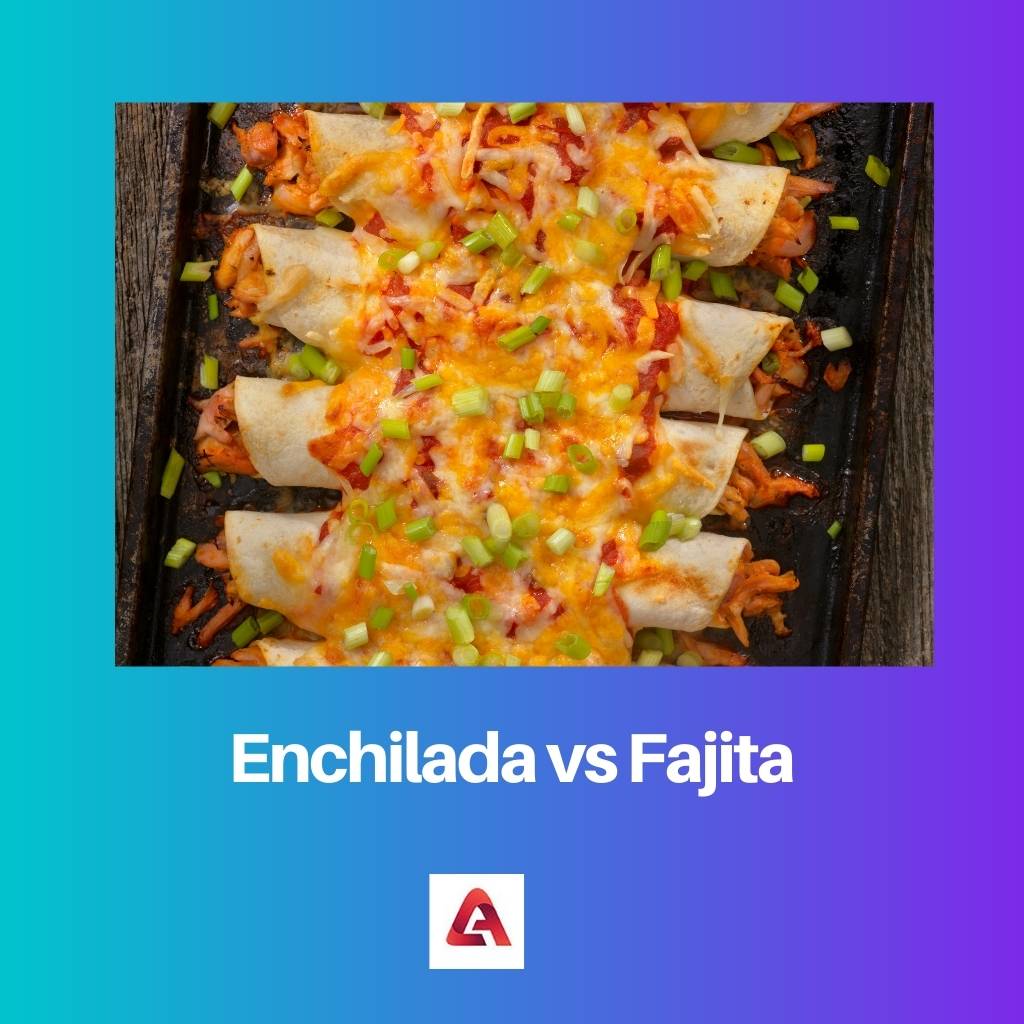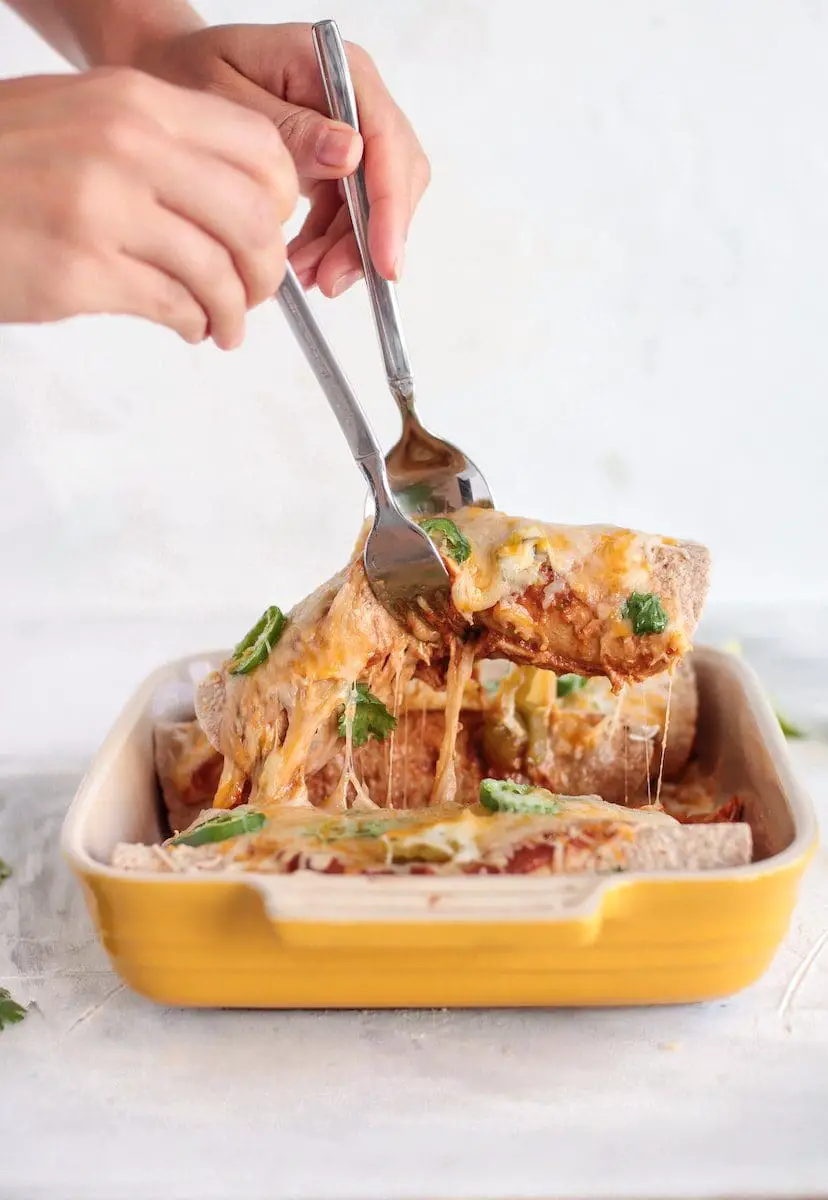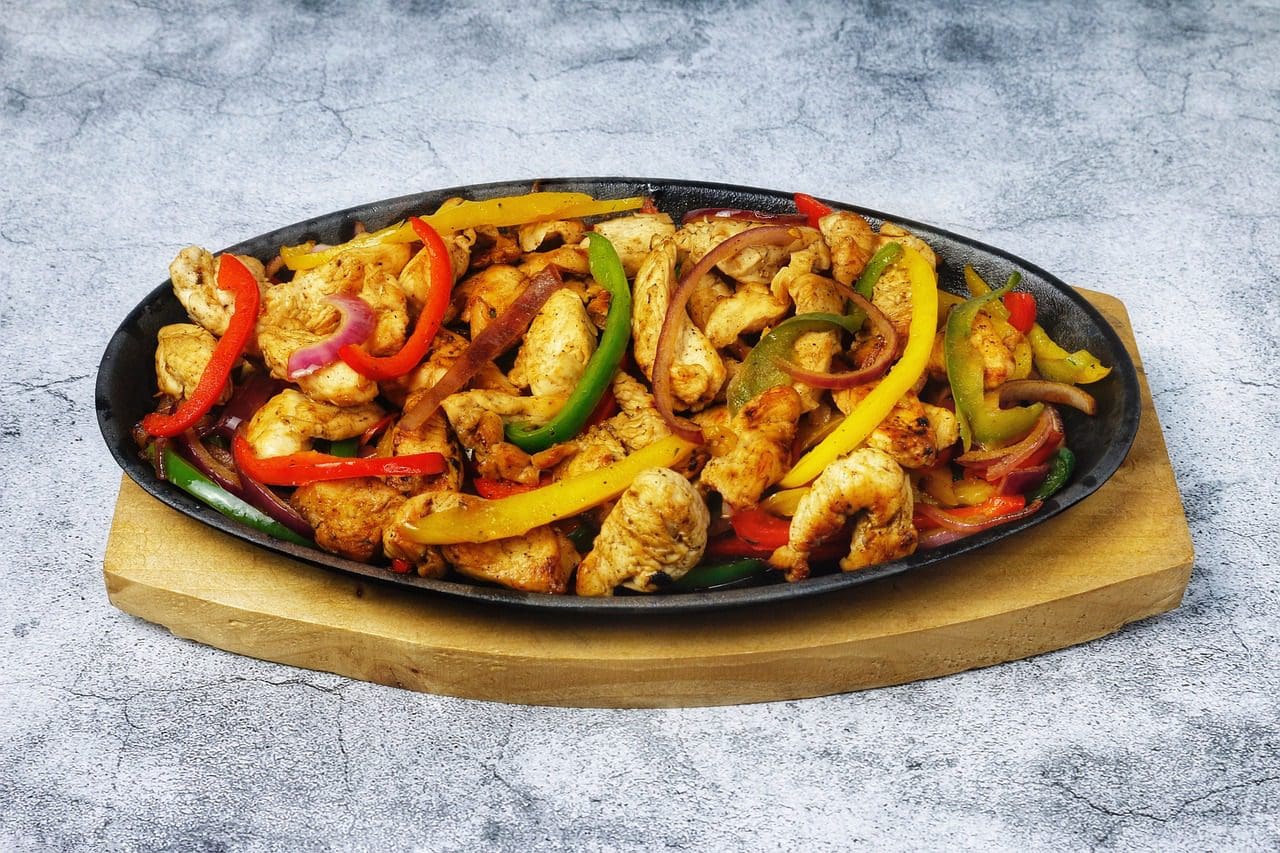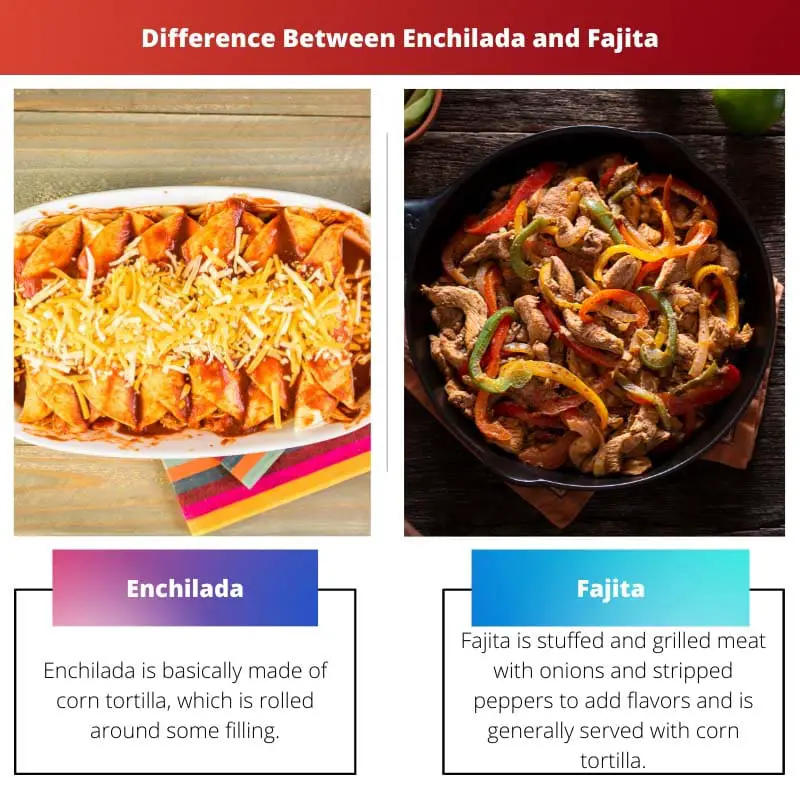Both enchilada and fajita are Mexican dishes and originated from there only. The main ingredient in both dishes is tortillas and some sausages. People in Mexico and in the united states are very fond of these dishes. It is majorly eaten in those areas only.
Enchilada is basically made of corn tortilla, which is rolled around some filling that depends on the person eating it and is then covered with a savoury sauce.
Fajita is stuffed and fairly grilled meat with onions and stripped peppers to add flavour and is served with corn tortilla or on flour.
Key Takeaways
- Enchiladas are a Mexican dish consisting of a tortilla filled with meat, beans, or cheese, covered with chilli sauce, and baked, while Fajita is a Tex-Mex dish made with grilled meat, vegetables, and tortillas.
- Enchiladas are rolled up and covered in sauce, while Fajitas are served with meat and vegetables separate from the tortillas.
- Enchiladas are commonly baked in the oven, while Fajitas are grilled or sautéed on a skillet.
Enchilada vs Fajita
The difference between enchilada and fajita is that enchiladas are shredded meat and are then rolled in corn tortillas and then they are covered in red or green enchiladas sauce according to the choice and then baked as the final step, while fajita is strips of meat that can be either sautéed or grilled according to the will.

Enchilada is basically made of corn tortilla, which is rolled around some filling that depends on the person eating it and is then covered with a savoury sauce.
As for ingredients, enchiladas can be filled with many different them as per the choice, like- cheese, meat, potatoes, beans, and other combinations of vegetables.
Fajita is stuffed and fairly grilled meat with onions and stripped peppers to add flavour and is served with corn tortilla or on flour. Popularly the meat used in the fajitas as an ingredient is chicken, and cuts of beef sometimes can also include vegetables instead of meat.
The meat is cooked with several vegetables to give it extra flavour.
Comparison Table
| Parameters of Comparison | Enchilada | Fajita |
|---|---|---|
| Countries of origin | Mexico | United states and Mexico. |
| What are they? | Enchilada is basically made of corn tortilla, which is rolled around some filling that depends on the person eating it and is then covered with a savory sauce. | Fajita is stuffed, and fairly grilled meat with onions and stripped peppers to add flavors and is served with corn tortilla or on flour. |
| Major Ingredients | Tortilla, meat, and vegetables. | Tortilla, cheese, onions, meat, chicken, peppers. |
| Condiments | Cheese, meat, potatoes, beans, and other combinations of vegetables. | Shredded lettuce, sour cream, salsa sauce, shredded beans, cheese, and tomatoes after they are diced finely. |
| Meat and vegetables | Enchiladas are eaten with meat and several combinations of vegetables according to the need and choice. | Fajita can be eaten with meat, chicken, and beef or with vegetables, or both. |
What is Enchilada?
Enchilada is basically made of corn tortilla, which is rolled around some filling that depends on the person eating it and is then covered with a savoury sauce.
As for ingredients, enchiladas can be filled with many different them as per the choice, like- cheese, meat, potatoes, beans, and other combinations of vegetables.
The sauces used in enchiladas include several other sauces like chilli-based sauce, salsa sauce, moles, and cheese-based sauce.
As mentioned above, enchiladas originated in Mexico, where the practice of rolling tortillas started in earlier times. People living around and in the lake region of Mexico used to eat corn tortillas and used to roll them around cooked fish.
The real and original academia of enchiladas which is Spanish defines it as the word enchilada, and this is what is used in the states of Mexico as rolled and stuffed tortilla, which is covered in sauces and is filled with meat and vegetables.

What is Fajita?
Fajita is stuffed and fairly grilled meat with onions and stripped peppers to add flavour and is served with corn tortilla or on flour. Popularly the meat used in the fajitas as an ingredient is chicken, and cuts of beef sometimes can also include vegetables instead of meat.
The meat is cooked with several vegetables to give it extra flavour.
Some of the very popular condiments used in various fajitas are shredded lettuce, sour cream, salsa sauce, shredded beans, cheese, and tomatoes after they are diced finely.
In some of the restaurants, fajitas are brought to the table with vegetables and meat with a sizzling and loud sound on a metal platter or on a skillet, with the tortillas separately that are warmed.
As of now, fajitas are made with many different fillings and sauces like- green, red, or yellow peppers, chillies, onions, tomatoes, and even jalapeno peppers too.

Main Differences Between Enchilada and Fajita
- The main difference between enchiladas and fajita is that enchiladas are shredded meat and are then rolled in corn tortillas and then they are covered in red or green enchiladas sauce according to the choice and then baked as the final step, while fajita is strips of meat that can be either sautéed or grilled according to the will.
- Enchiladas’ country of origin is Mexico, while fajita’s country of origin is Mexico and the united states.
- The main ingredients of enchiladas are- Tortilla, meat, and vegetables, while the main ingredients of fajita are- Tortilla, cheese, onions, meat, chicken, and peppers.
- Condiments included in enchiladas are- Cheese, meat, potatoes, beans, and other combinations of vegetables, while condiments included in fajitas are- Shredded lettuce, sour cream, salsa sauce, shredded beans, cheese, and tomatoes after they are diced finely.
- Enchiladas are eaten with meat and several combinations of vegetables according to the need and choice, while Fajitas can be eaten with meat, chicken, and beef or with vegetables or both.

- https://www.mdpi.com/2304-8158/9/2/177
- https://muse.jhu.edu/article/51722/summary
- https://books.google.com/books?hl=en&lr=&id=tH-4CgAAQBAJ&oi=fnd&pg=PR15&dq=enchiladas+mexican+dish&ots=zglSz-aoTA&sig=_x9QPjc2dD-Q4_MflTV7ziA2dsM

The comprehensive comparison of enchilada and fajita, including their origins, ingredients, and cultural influences, makes this article an invaluable resource for understanding Mexican cuisine.
The thorough exploration of the ingredients and cooking methods of enchilada and fajita allows readers to gain a profound understanding of these traditional dishes.
Absolutely, the article’s detailed analysis and scholarly approach contribute to a deeper appreciation of these classic Mexican dishes.
The detailed explanation of the sauces and condiments used with enchiladas and fajitas is important in understanding the flavors of these dishes. This article captures their essence excellently.
The article effectively delineates the unique features of enchilada and fajita, providing an insightful comparison of their ingredients, cooking styles, and cultural backgrounds.
Absolutely, the article presents a nuanced analysis of the differences and similarities between these two iconic Mexican dishes.
The article’s emphasis on the original recipes and traditional practices related to enchilada and fajita enhances its credibility. It’s a well-researched piece of work.
I agree. The historical and cultural context provided for both dishes adds depth and authenticity to the information presented.
The article’s rich portrayal of the culinary heritage and traditional aspects of enchilada and fajita is commendable. It’s a fascinating read for food enthusiasts and cultural scholars alike.
Indeed, the article’s attention to historical and cultural details enriches the reader’s experience and understanding of these iconic Mexican delicacies.
The article provides an in-depth understanding of the regional origins of enchilada and fajita, shedding light on their cultural significance and traditional preparation methods.
Agreed. The information about the cultural and historical aspects of these dishes adds depth and value to the article.
It’s clear that the author has conducted thorough research to present such detailed and accurate information on enchiladas and fajitas.
The descriptions of enchilada and fajita are very thorough. It’s evident that the author has in-depth knowledge of these Mexican dishes. Well done.
I agree, the article provides valuable insights into the traditional preparation and consumption of enchiladas and fajitas.
The comparison table is particularly useful for understanding the key differences between the two dishes. It enhances the clarity of the explanations.
The article comprehensively explains the differences between enchilada and fajita. It highlights the origins, ingredients, and condiments of both dishes. It’s informative and well-written.
I agree. The historical background of the dishes provides an interesting context for understanding their cultural significance.
Absolutely, the detailed comparison table makes it easier to differentiate between enchilada and fajita. Great information overall.
The cultural significance and historical context of enchilada and fajita are interesting aspects to explore. The article does a great job in conveying this information.
The article’s explanation of the ingredients and the distinction in the preparation methods for enchilada and fajita is quite enlightening. It’s a good read for anyone interested in Mexican cuisine.